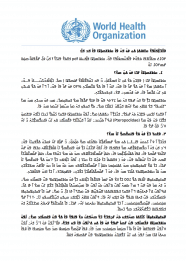| Title | Sayidangwa Kunafonin |
|---|---|
| Alternative Title | Information on Ebola |
| Creator | Boubacar Diakite |
| Subject | Ebola Virus |
| Description | This is some useful information on the Ebola virus. |
| Language | Bamanankan |
| Script | N’ko |
| Pagination | 10 pages |
| Date | 2014 |
| City | Boston |
English Translation of Page 1
The risk of a tourist or businessman/woman becoming infected with Ebola virus during a visit to the affected
areas and developing disease after returning is extremely low, even if the visit included travel to the local areas
from which primary cases have been reported. Transmission requires direct contact with blood, secretions,
organs or other body fluids of infected living or dead persons or animal, all of which are unlikely exposures for
the average traveller. In any event, tourists are advised to avoid all such contacts.
If you are visiting family or friends in the affected areas, the risk is similarly low, unless you have direct physical
contact with a person who is ill or who has died. If this is the case, it is important to notify public health
authorities and engage in contact tracing. Contact tracing is used to confirm you have not been exposed to
EVD and to prevent further spread of the disease through monitoring.
WHO’s general travel advice
- Travellers should avoid all contact with infected patients.
- Health workers traveling to affected areas should strictly follow WHO‐recommended infection control guidance.
- Anyone who has stayed in areas where cases were recently reported should be aware of the symptoms of infection and seek medical attention at the first sign of illness.
- Clinicians caring for travellers returning from affected areas with compatible symptoms are advised to consider the possibility of Ebola virus disease.
For additional travel advise, please read the Travel and transport risk assessment: Recommendations for public health authorities and transport sector at http://who.int/ith/updates/20140421/en/.
